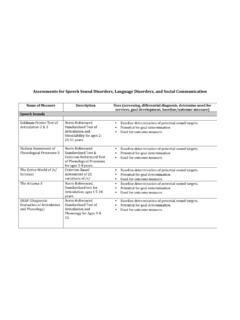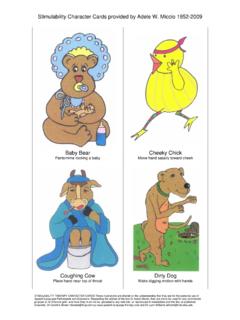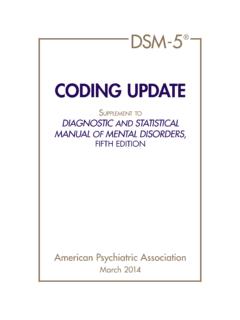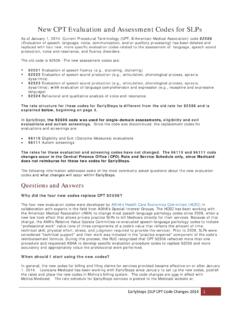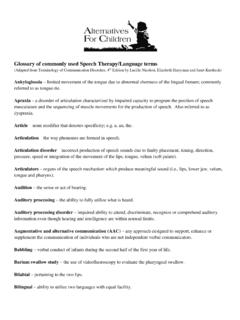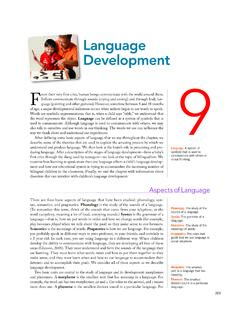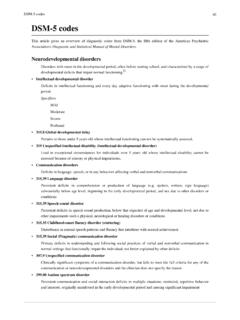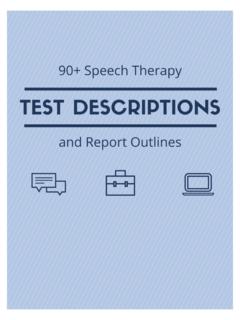Transcription of How to Use Play to Promote Language Development
1 How to Use play to Promote Language DevelopmentCarrie Clark, CCC-SLPThe Speech Therapy of play for ChildrenPretend play : Imaginative thinking and exploration leads to Abstract thinking Problem Solving Life skills Leadership skills Communication Development Social Skills Development Use of Theory of Mind (understanding/taking another s perspective) Understanding of safety Self-confidence and a high self-esteemSource: play and Language Development are Related Brady et al. (2004) and McCatheren et al. (1999) showed that children who used symbolic play had better outcomes in therapy play and Language Development tend to mirror each other. If a child has met their play milestones but not Language , it will be easier for them to learn Language . However, if they have neither, it makes sense to elicit both the play and the Language skills in tandem as the skills may reinforce each other(Rhea Paul: Language disorders pg 270)How to Assess play Multicultural Considerations: Identify the type of play the child is doing as well as the social level of play : Identify if the child s play is low compared to age as well as compared to other developmental skillsWestby play Scale In 1980, Carol Westby created an assessment/scale that shows you what play skills children should have at certain ages as well as the Language skills that should parallel them: play Skills are Impaired Understand where the child is in the developmental progression of play skills.
2 Imitate and praise the child s play skills that are at his level and model and encourage play skills that are slightly above his level. Teach parents how to play with the child at his developmental level When possible, work on parallel Language and play skills together as in the Westby play ScaleImproving play When the Child is Stuck in Functional/Sensory play Hold items that the child is exploring close to your face Encourage social games like peek-a-boo, horsey rides, etc.(Source: ) Establish joint attention: Model constructional play like building with blocks Model auto-symbolic play (pretending on yourself drinking from cup, going to sleep, etc.)Expanding play for Children in the Constructive play Phase Show them how to extend the play they re already doing (stacking blocks and then parking a car inside) Introduce them to a larger range of materials(Source: ) Model auto-symbolic play (pretend play on yourself) Model tool use (using a stick to reach/activate a toy)Expanding play for Children in the Symbolic/Dramatic play Phases Model more types of auto-symbolic play (on yourself) Model symbolic play that extends beyond the child s self (taking care of baby dolls or pretending to feed others) Model pretend play by combining multiple toys or materials together (stirring with spoon in pot or driving cars through block structures) Role play daily, familiar activities Role play novel, less frequently occurring activities Link two or more pretend play actions togetherExpanding play for Children with Solitary play Get close to the child and do your own play (similar to what the child is doing) near him Encourage the child to be near other children when playing Place other children who are playing similarly near the childGoal.
3 Tolerating Parallel PlayExpanding play for Children with Parallel play Set up activities where the children must share materials even though they won t necessarily be playing directly togetheroOne sand table/sensory tuboOne tub of art suppliesoOne set of blocksoOne set of cars on a road play mat Pair the child up with other children who play similarly with those materials Start with only one other child and introduce more children as possibleGoal: Associative PlayExpanding play for Children with Associative play Set up activities where the children will have to work together to complete the activityoPlaying on a see saw/rocking boatoPlaying catchoPulling each other in a wagon Stage pretend activities by getting the children startedoAssign roles in a scenario ( you re the dad, you re the mom, and here s your baby )oPair the student with difficulties with more capable students who will take a more dominant role (at first)Goal: Cooperative PlayHow to Teach Language Through play When play skills are not impaired, you don t have to teach them directly but can instead use play to make your lessons more memorable and to teach Language .
4 This is especially effective for young children or those who are resistant to drill-and-practice type work. play makes lessons more engaging which means the child is more likely to remember the lessons and activities afterwards. They are also more likely to reenact lessons that you did and practice the skills laterHow to Set Up a play -Based Session1. Choose your targets: decide ahead of time what you will target2. Create an episodic story-like play scenario that will allow multiple opportunities to practice/demonstrate the skill: The more story-like it is, the better they will remember. Associated events scaffold memories 3. Make your targets memorable: Find ways to work your targets into the meaningful parts of the story. For example, if you re working on a certain sound, have the doll s name start with the sound and bring in real objects for the doll to play with that start with that soundSource: of play -Based Sessions to Target Different SkillsThe following slides demonstrate some examples of play -based activities that you could do to target various speech and Language skills: ArticulationPlay-Based Session for ArticulationPuppet Goes to a Party: Get out a puppet and name him something that contains your target sound Tell the child a story that the puppet is going to a party and he must bring food that contains your sound Go through a bag and pull out all of the play food (or real food!)
5 And talk about if it starts with the sound Once you find several things, pretend to cook them and prepare them in dishes for the party (or make real food like a snack mix full of foods that contain the sound!) play -Based Session for Vocab (Clothes)Puppet Does Laundry Introduce Puppet and explain that puppet is in trouble because she didn t do her chores. She wants to go play outside in the snow but she has to do her laundry first Bring out a basket of laundry and ask the child if she can help sort Put piles/tubs out that are labeled with different types of clothing (the words you want to target) Help the child sort the clothes into the correct tubs so Puppet can go out to play Once the chore is done, help Puppet pick out the correct clothing items to go play in the snow (or go swimming, etc.) play -Based Session for Vocab (Categorizing)Playing House Choose objects from 2 different categories (or however many the child needs to work on) and throw them around the room.
6 When the child comes in, tell her you re playing house. She s the mom and you re the unruly child. She has to tell you to clean up your room. Have the child look at all the stuff with you and decide on the 3 categories that will be used. She has to tell you to sort things into the 3 categories Ask her for help on sorting the first few items and then once you get it , have her watch you to make sure you do it right. Screw up often so she has a chance to correct Session for Vocab (Descriptors)My Monster Triplets Get three monster (or animal) stuffed animals and put them in high chairs, bumbo seats, or other baby seats. When the child walks in, say thank goodness you re here! My triplets are here with me and they are HUNGRY but they re so picky. I need you to help me feed them. Tell the child that each of the monsters will only eat things of a particular descriptor (hard, soft, sticky, sweet, green, round, etc.). Have pictures of objects (or real objects) that match each of the 3 descriptors Help the child decide which monster will eat each of the foods based on the descriptorsPlay-Based Session for Grammar (Pronouns He/She)Babysitting Twins Get two baby dolls (a boy and a girl).
7 Place the babies in two different holders, like cribs, strollers, or baby carriers. Tell the child that the twins need to be taken care of but they re very fussy. Hold up baby items and tell her that one of the babies needs it (like a bottle). Say he needs it or she needsit . Help the child determine which baby needs it based on the gender and the pronounPlay-Based Session for Grammar (Articles a/some )Playing Chef Pretend the child is a chef at a fancy restaurant and you are his sou chef. Make up recipe cards by taking pictures of groups of play food ingredients and writing the dish name at the top. Some of the ingredients should come in pairs or large groups while others are single. Have the child draw a card and pretend that is an order coming in. Have the child tell you what ingredients are needed by saying a ___ or some ____ depending on if he needs one or more than one. Have the child put the ingredients in the pot and stir them to cook the dishPlay-Based Session for Grammar (Past Tense)Playing Reporter Tell the child that he needs to be a news reporter.
8 Act out a scene by yourself, with other children, or with puppets and have the child take pictures of the event with your phone or digital camera Have the child use the photos that he took to re-tell the story using past tense verbs. Give the child a pretend microphone and have him say the newscast for the others in the room or for a camera (real/pretend) play -Based Session for Asking QuestionsPlaying Detective Pretend the child is a detective coming in to work. Tell him the details of the case of the missing cookie jar. Tell him the cookie jar was in the kitchen when Mom and Dad left to go to a movie. The babysitter, Billy, and Molly were all present in the house during the event along with the cat and the dog. Pretend to be each of the characters (or use puppets) and have the child ask each character questions to figure out who stole the cookie jar and where they hid Session for Answering QuestionsTaking your Baby to the Doctor/ER Uh oh! Baby got hurt.
9 Act out a scene where a doll falls off a bike, runs into a wall, or some other disaster strikes. Tell the child she must take the doll to the doctor or to the emergency room. When she gets there, pretend you re the doctor and ask her questions about what happened so you can help make her to Obtain Continuing Education Credit If you need continuing education credit for this presentation, please email Carrie at to receive a copy of the continuing education certification letter. You will receive 1 Certification Maintenance Hour (CMH) for attending live, which is like a CEU but I can t report it to ASHA so you ll need to keep track of this form and report it yourself. Let me know if you are outside the US or are not a certified member of ASHA (you ll get a different certificate)** I can only offer credit for those who attend live, not for watching the recording after the fact. Sorry!

